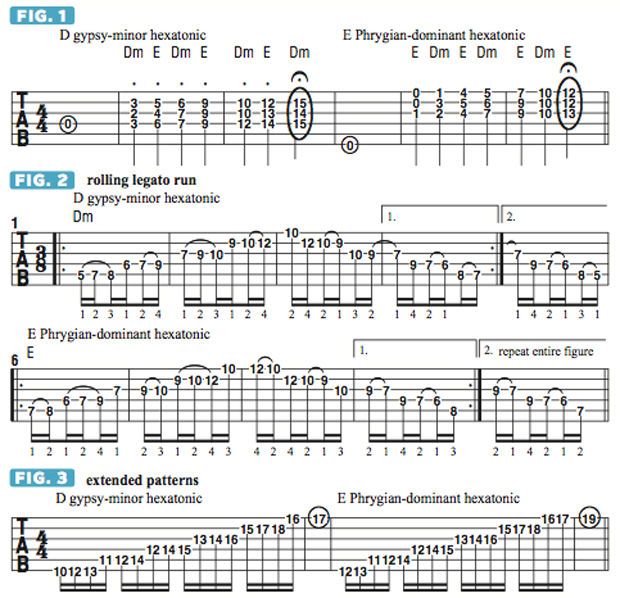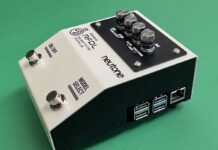
Clever Ways to Conjure Haunting, Mysterious Melodies
In the April 2015 issue of Guitar World, I showed you how to combine D major (D F# A) and E minor (E G B) triads to generate two appealing hexatonic (six-note) scales: the bright, joyous-sounding D major hexatonic (D E F# G A B) and the dark and serious E minor hexatonic (E F# G A B D).
As we saw, both scales are made up of the same notes, the only difference being their orientation around either a D or an E root. I’d now like to present a neat twist on this formula, one that yields two hauntingly beautiful hexatonics, both of which could serve as useful resources whenever you’re looking to create a mysterious, exotic musical mood.
The twist is, instead of combining E minor and D major triads, we’re now going to combine D minor (D F A) and E major (E G# B), as demonstrated in FIGURE 1 with two sets of chord inversions moving up the fretboard. In both cases, the notes on the highest of the three strings outline the scale and the notes on the two lower strings offer harmony.
You may recognize the sounds created by these two ascending chord-scales, as they’re nearly identical to those of the fourth and fifth modes of A harmonic minor (A B C D E F G#), what are known as D “gypsy” minor (or “Hungarian” or “Ukrainian” minor: D E F G# A B C) and E Phrygian-dominant (E F G# A B C D), a mode often associated with both classical music and metal and the virtuosic shredding of Yngwie Malmsteen.
The only difference between those seven-note modes and their hexatonic subsets shown in FIGURE 1, which we’ll refer to, respectively, as D “gypsy-minor hexatonic” (D E F G# A B) and E “Phrygian-dominant hexatonic” (E F G# A B D), is the absence of a C note in the hexatonics, which results in a wide, pentatonic-like gap between B and D. D gypsy-minor hexatonic sports a minor third, F, and major sixth, B, which, together with the second, or ninth, E, create a melancholy Dm6-9 sound (D F A B E).
It also features a raised, or “sharped,” fourth, G#, which lends the scale a bitter, dissonant bite that, to me, brings to mind the folk music of Transylvania and neighboring regions of Southeastern Europe. E Phrygian-dominant hexatonic melodically describes an E7 sound (E G# B D) and also includes a fourth, A, and flatted second/ninth, F, which together conjure a feeling of suspense and tension.
To me, this scale has a Middle-Eastern or North-African vibe. Both scales and their respective tonal centers—D minor and E major—yearn to resolve to their parent A minor tonality, and it’s the postponement or denial of this resolution that creates musical drama.
FIGURE 2 is a fluid-sounding legato run in 6/8 meter that demonstrates a useful two-octave path for both of these shared-note hextonic scales that diagonally crosses the middle area of the fretboard. Notice the symmetrically recurring three-notes-per-string shapes and how, at the end of bars 5 and 10, I skip over a note in order to smoothly transition to the other scale. Strive to make all your hammer-ons strong and firm and, when pulling-off, pull the string slightly in toward your palm, in an effort to make all the notes project at an even volume.
Once you’ve mastered this run, try doing the same thing with the longer two-and-one-half-octave shapes illustrated in FIGURE 3, both of which are essentially the same three-notes-per-string patterns from FIGURE 2, shifted up five frets and starting on the low E string. Experiment with various rhythms, articulations and phrasing schemes, such as playing straight 16th notes in 4/4 and using alternate picking patterns or bends and slides, as I demonstrate in the video lesson for this column.

Source: www.guitarworld.com







